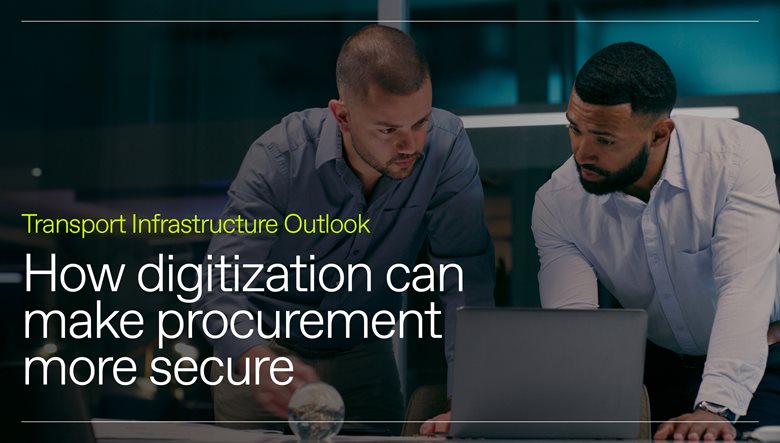Tech makes transport infrastructure procurement more secure
While analogue legacy systems persist, digital tools protect global project partners.
By AnsaradaMon Jun 16 2025Advisors, Industry news and trends, Tenders

For procurement and project teams charged with delivering high value transport infrastructure initiatives, unauthorized access of data can have significant negative repercussions. The untimely release of sensitive planning data, for example, can result in public controversy, while any suggestion the integrity of a confidential bidding process has been compromised will inevitably damage project credibility and the careers of those who are ultimately deemed to be responsible.
Drawing on our 2025 Transport Infrastructure Outlook Report, developed in partnership with Infralogic, this blog explores common vulnerabilities within the procurement process and outlines how digital procurement technology can help mitigate them.
1. Analogue procurement persists
In many parts of the world, including in developed nations, legacy procurement practices and platforms remain prevalent. This is despite the fact that the quality of software in use is deemed essential or very important to procurement. Close to half of government agencies consider it critical, along with 31% of advisory firms.
Yet, only 39% of survey respondents used digital procurement software in their most recent project. Uptake to date has been highest in the Americas, where 50% of organizations have deployed specialist tools, and lowest across Asia Pacific. Although there has been a surge in transport infrastructure spending in recent years, they are utilized on just one in four projects in that region.
Contractors tend to be the earliest adopters and government agencies the laggards. Just 31% of the latter use digital procurement tools, despite the significant cost savings and efficiency benefits they can deliver.
Instead, the focus very often is on short-sighted cost minimization. Public sector entities and suppliers are effectively incentivized to continue using inferior in-house tools and manual methodologies which lay the procurement process open to unnecessary and avoidable risk.
2. Awaiting the inevitable breach
Because while the uptake of next generation technology may have been sluggish to date, the integrity issues associated with outmoded systems and solutions are scarcely a secret.
More than a third of survey respondents admitted to having no confidence in the security of their procurement process, with deepest concerns expressed by government agencies.
The risks they face can be compounded by staff movement; an inevitability when procurement processes are protracted, as they tend to be when nine and ten figure project budgets are in play. Industrial espionage is not unheard of and, in the absence of strong data access controls, entities may be powerless to prevent departing employees taking valuable information with them and sharing it with unauthorized parties.
“If someone has had access to sensitive procurement data while working for one bidder and moves to another, how do you ensure that information doesn’t give the new employer an unfair advantage?” C2 Consulting Principal and Managing Director Craig Covil asks.
While budget constraints continue to stymie their embrace of digital procurement technology, many government entities have the sense they’re sitting on a ticking time bomb.
3. Identifying and addressing points of weakness
Email, for example, is still used by 83% of teams, to communicate with stakeholders, and share and collate documents and data. It’s not uncommon for critical information to become buried in lengthy threads, and the requirement to track information flows can be a heavy burden for hard pressed procurement teams.
Our research suggests it can inflate the administrative workload by as much as 80% for a team operating in manual mode.
It’s also far too easy for unauthorized individuals to gain access to data, or for it to be accidentally lost or shared.
4. Adding resilience and rigor to procurement
This becomes less of an issue when a dedicated digital repository is used to store documents, disseminate data to stakeholders and manage the bidding process.
Information flows, including document version controls and exchanges of sensitive information, can be tracked and monitored at a granular level, and the risk of sensitive documents being inappropriately accessed or distributed is vastly reduced.
Maintaining the comprehensive audit trail taxpayers expect when public money is expended on infrastructure projects becomes an easier proposition too, if procurement teams can utilize automated workflows and digital time stamping.
On complex, high value projects, having this additional security and rigor baked into the procurement process is invaluable.
“The scale of data in infrastructure procurement today is enormous. Digital platforms make managing that data more efficient. They provide layered security, control over who sees what, and ensure that bidders receive information at the same time,” says C2 Consulting’s Covil.
5. Driving the uptake of secure digital procurement technology
From a data security perspective, the case for migrating from manual processes and practices to a fortified digital procurement environment is well made out and the risks associated with not doing so is starkly apparent.
For agencies and suppliers that want to ensure the integrity and success of current and future transport infrastructure initiatives, adopting robust, secure platforms should be an urgent imperative.


